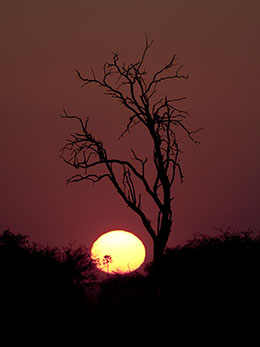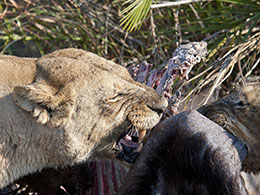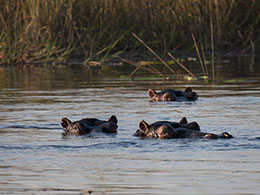Safari at Duba Plains Camp, Botswana
 Sunset in the Okavango Delta
Sunset in the Okavango DeltaOur trip to Africa was primarily for the safari opportunities in Botswana. Having thought about and talked about this trip for years, we were rather excited to finally be here. Our first destination in Botswana was the Duba Plains Camp. For those that just want the summary it was awesome!
We left Johannesburg in the morning and the flight to Maun, Botswana took about 1.5 hours. From here it was a 30 minute charter flight to the small airstrip serving the Duba Plains Safari Camp. We arrived around 2:30pm.
Upon arrival we were greeted by Duba Plains staff, one of which provided us with a moist towel to wipe our hands and face. Although well past the lunch hour, we were still fed a delicious meal while simultaneously being briefed on the camp and its amenities.
Safari Day 1: Afternoon
Our first safari drive kicked off at 3:30pm. We had our guide, James, to ourselves which was nice. We drove back to the runway and then into the bush where we saw 4 giraffes; one was older, 2 were younger, and the fourth was unknown due to being hidden behind trees. We learned that you can get a sense of a giraffe's age by how dark their markings are — the darker the markings the older the giraffe.
After some time we moved on with our safari drive and encountered a pangolin (similar to an armadillo). These animals are quite rare sights so we were definitely off to a good start with our trip. As it turns out, there was a second pangolin about 100 feet away. Our guide told us that he's never seen two pangolin together before. He was more excited than we were which is pretty cool considering we were really excited.
Unfortunately, pangolins are quite shy and within moments of our spotting them they tucked their heads into a bush and remained motionless making for not so good photos. I did manage to get one decent shot though. We eventually had to move on as nightfall approached.
Also on this outing we saw a red lechwe and an open-billed crane.
Safari Day 2: Morning
Our first morning safari started at 7:00am. I'll let you work out what time we had to wake to have breakfast. While it may seem early, if your primary purpose is to see wildlife and the early morning light makes for great photos, then you'll understand why the day starts so early.
By 7:00am there was actually a decent amount of daylight. This time around we started off with a short boat ride across some water to where our jeep was already parked. In no time we were off for the day's drive.
Our first major sighting was a small group of elephants by the water that just started to cross it while we were there. There were adults, teenagers, and a baby. Our guide's driving style is to approach slowly and to never approach from the front so as to not alter the animal's natural behavior. In the case of these elephants, there was nothing more than a false charge or two which is typical elephant behavior.
 Red Lechwe Were Everywhere
Red Lechwe Were EverywhereAfter the elephants we saw 2 ostriches that quickly bolted as we approached. Their running in turn triggered a run by the nearby red lechwe and both continued to run for some time. A good sighting but the animals were too far for photos.
Continuing on we came across a family of warthogs, some kudu, stork, crane, and a hornbill.
We eventually came to a lake with a dozen or so hippos, a crocodile on one bank, and a herd of red lechwe on another. We parked here for a bit for morning tea. While watching these animals, elephants walked in the distance and we also saw some warthogs in the distance.
On our way away from the lake we came across a black striped jackal and a long grey mongoose. Our final sighting before returning to the boat ramp was a troupe of baboons amongst the grasses.
Safari Day 2: Afternoon
The afternoon safari kicked off around 4pm again with a quick boat ride to the jeep. Our excursion started with sightings of a little bee eater (bird) and coppery tailed coucal.
Further into the drive we saw waterbok, reed buck, more red lechwe, and tsessebe.
We then came upon a herd of elephants close to sunset and stayed with them for a while. They were grazing among the water and grasses and James, our guide, informed us that the rich landscape and soft foods enabled these elephants to live longer than elephants elsewhere in the world due to their teeth not being ground down as fast. It's sad to think that elephants die because their teeth wear out and they can't eat. Some of the elephants eventually moved out of the water and onto dry land where they proceeded to grab tusk-fulls of sand which they then threw over their bodies. Pretty cool behavior to witness.
Safari Day 3: Morning
As with the previous morning, we started out with a boat ride to the jeeps. We learned at this point that this side of the delta was better for animal viewing. This time around we were accompanied by another couple from the state of Virginia in the US. I was wondering if our guide would adjust things since there were two new folks i.e. go out to sure sightings that we had already seen, but that turned out to not matter. The “mission” for the day was to find the local lions and so we set off looking for and following lion tracks.
Our guide is very skilled in this area — not just because he says so, but you could actually see it from his behavior. We also learned that he helped out two writers/filmmakers with their book Relentless Enemies and the new Disney movie The Last Lion which are pretty impressive notations from his 15 years of tracking experience. Even the President of Botswana sought him out when he went on safari (6 times) — James has a picture to that fact. The newest generation of Botswanians are learning to track cattle, but those skills are transferable and can be augmented with training from people like James.
 Lioness Feasting on a Buffalo
Lioness Feasting on a BuffaloI have to say that tracking in and of itself was fun — the constant expectation of seeing something based on fresh tracks; sitting quietly listening for sounds from the lions, and wondering what James has found on his mini walking excursions from the jeep.
I did get nervous when we started to double back at one point. I thought we might be doomed having lost the tracks, but James kept us on the hunt and we were rewarded with an awesome find of lions feasting on a buffalo — a kill from late evening the previous day. By the time we reached the kill site there wasn't much left of the buffalo, just some skin and the legs, enough had been eaten that the ribs were completely bare.
There were 11 lions from the Tsaro pride in total with 6 of them being cubs. The male pride leader was not there. Typical behavior is to partake of the kill that the females have, but to otherwise roam the territory and defend it against other males. Not all of the lions were in on the hunt as some apparently joined the feast afterwards, but even with some growls these other lions were allowed to eat since they were from the same pride. According to James, we had tracked the lions that had come later, 2 females and 2 cubs.
Given our great find, James radioed another jeep from the camp who eventually joined us, but aside from them we had the lions all to ourselves. This exclusive experience is apparently different than other countries such as Kenya where the safaris are not as well regulated and literally crowds gather around kill sites as the news spreads.
While it may sound odd, we broke out snacks and coffee and stayed with the lions for some time. Many, many photos later we started to head back to the camp. Well worth getting up at 6am and the 4 hours spent out in the field!
Safari Day 3: Afternoon
We headed out on a boat-only trip this afternoon. A motorized-boat not the region's traditional makoro (a canoe-like boat). Apparently the conditions are not appropriate for a makoro and potentially dangerous with all of the hippos in these waters — we know that hippos are close by as we've been hearing them thrashing and splashing in the water at night. They actually sound like they're right outside the tent door, but we haven't really seen them that close.
 3 Of The 10 or So Hippos We Came Across
3 Of The 10 or So Hippos We Came AcrossHaving been warned by another camp visitor about the bugs on the river we've come prepared with head nets and goggles — the bugs don't bite, but rather get into your eyes and mouth when the boat is speeding along. In the end we discovered that the bugs weren't all that much of a problem if you kept your mouth and eyes closed as the boat sped along.
The main attraction of the boat trip turned out to be the hippos in the water. We came upon 10 or so hippos bobbing in the water taking turns submerging and then surfacing. We couldn't see the full bodies of any of them, but there was one that opened its mouth wide 180 degrees and I captured a photo of that. The sunset made for great lighting.
Safari Day 4: Morning
We returned to the lion kill from the previous day. The lions were still around and the bones had been mostly picked cleaned — the ribs were a lot whiter today. After watching the lions for a bit a couple of them moved away from the kill. As the last female stepped away from the carcass she paused to let out a guttural sound signifying that they were done with the kill. Almost immediately the vultures swooped, but not too long after a cub chased them away.
We followed the lions as they moved away from the kill, but after having gone just 100 feet they stopped moving and lay down for a rest. We headed on to see other animals and sure enough we came across elephants, warthogs and a bateleur eagle.
Safari Day 4: Afternoon
Just before the safari we saw a water monitor cross in front of the main sitting area. A new animal and we hadn't even left yet!
On this drive we came across python tracks that led into a bush. There were no tracks coming out and sadly no python we could see. We had been told that snakes were still hibernating given the cold weather so this was a pleasant surprise.
We also came across a troupe of vervet monkeys
Safari Day 5: Morning
We visited the kill for a third time. Curiously the lions had moved, but not all that much. Luckily our patience paid off and after a short while the females and their cubs got up and moved towards the water. Apparently they were close to the territorial border between prides and so were moving away from it. All of this was preceded by the female making the guttural sound again with a response from the Skimmer pride off in the distance.
We set off again to follow the lions with our guide expertly positioning us to enable some great photos as the lions trudged through the water — water crossing are pretty cool!
This last safari drive in Duba Plains ended with a sighting of baboons in the grass.




Leave a Reply